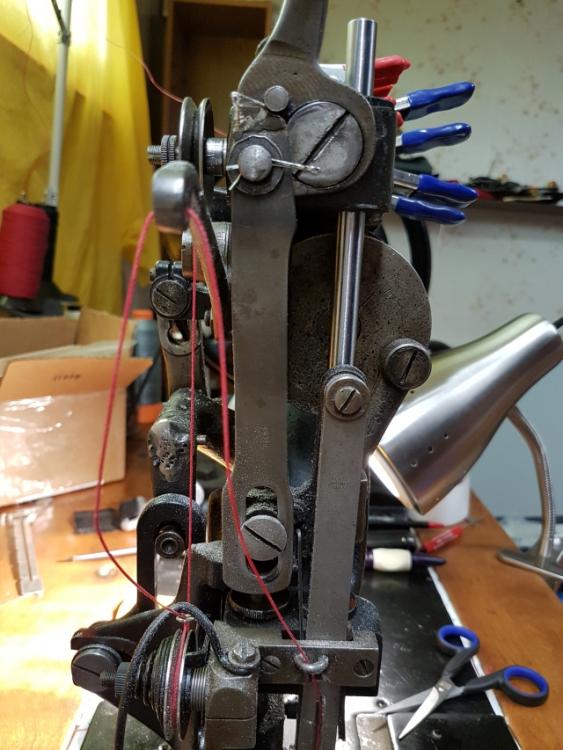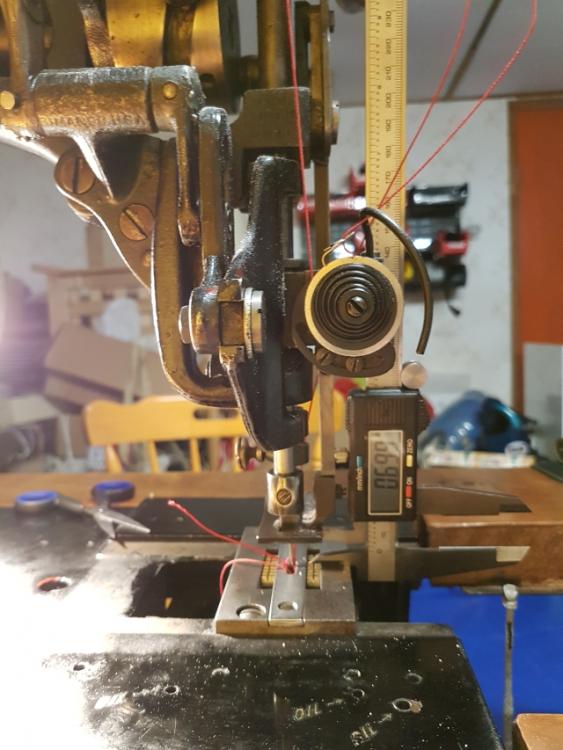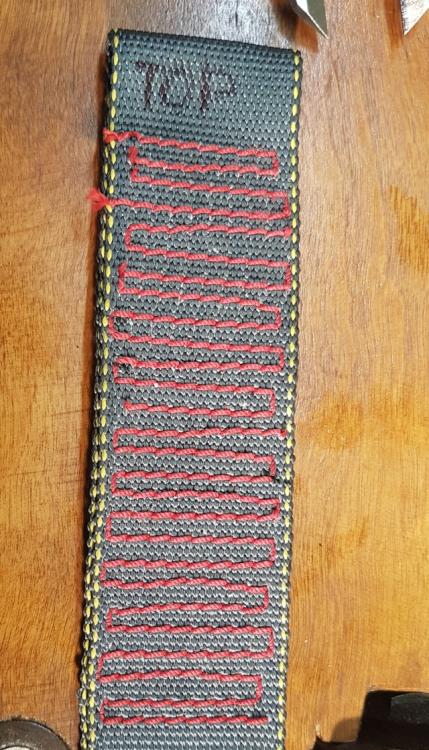
hackish
Members-
Posts
40 -
Joined
-
Last visited
Content Type
Profiles
Forums
Events
Blogs
Gallery
Everything posted by hackish
-
Gregg, if they fit then you should put them into a box addressed to me rather than back on your shelf. -Michael
- 16 replies
-
- feed dogs
- walking foot
-
(and 2 more)
Tagged with:
-
Thanks, constabulary, I looked but unfortunately it's far from what I need. The 205RB foot Gregg posted is exactly the piece I need. At most, I might grind a small ridge in the bottom of the inside foot, but a normal flat bottom worked just fine on my 20U and I did it for years. I really just need to know if the 205 feed dog and plate also fits. I'll post up some photos later today if I sew some more. -Michael
- 16 replies
-
- feed dogs
- walking foot
-
(and 2 more)
Tagged with:
-
I put it in quotes because it breaks at about 2500 lbs and it just doesn't feel right to call it "string". If I need to, I can grind teeth and machine feet as needed but some of my lines are thin enough they need that middle row. Is there any chance you'd have a plate and feet for a straight walking foot you could test fit to that machine? Having the dogs under the 205 feet is needed. I'd be quite happy to buy a package with all the pieces. -Michael
- 16 replies
-
- feed dogs
- walking foot
-
(and 2 more)
Tagged with:
-
Photo says what 100 diagrams won't. That's saved me a lot of guessing. The last step will be to find if the 205 plate and dog will fit. The other thing I'm up to here is getting that dog in the middle so I can sew down the middle of a "rope".
- 16 replies
-
- feed dogs
- walking foot
-
(and 2 more)
Tagged with:
-
Gregg, I was going to email you on this subject once I figured out exactly which parts were needed. I don't like to waste peoples' time on science experiments. The diagram I was looking at showed a 705A and 724A, which I believe is the 6 row plate/dog. It's specified for the 199, so I have no idea if it would fit on the 146 or not. I use the zig-zag feature for some parts, but in other cases, there isn't sufficient space for the outer foot, so I was thinking of trying to use a straight stitch foot. Cheaper than buying a complete second machine! As you can imagine, the original feed dog/plate wouldn't match, so it is an increasing gamble to order a plate, dogs and feet for a straight walking foot machine like a 205RB. Either it will work brilliantly or I will just wish I'd made the parts. Now you understand where my original question came from. -Michael
- 16 replies
-
- feed dogs
- walking foot
-
(and 2 more)
Tagged with:
-
As I understand, many years ago there was an agreement between most manufacturers to standardize the parts, needle plates, feed dogs, bobbins, presser feet and the like were then made and shared among manufacturers. I assume it was done as a cost savings measure so every factory and model did not need their own setup at a foundry. As a result, many things are compatible with only the finish machining done to make a part specific to a model. The challenge I have is just that the 146RB/199 is not the most common machine. Give me the casting blanks and I could machine the pieces I need. Otherwise, it's time-consuming to setup things like machining teeth in a piece of billet, especially on a low-quality manual benchtop mill. On a more positive note, I discovered that the person before me had hacked up the inner foot for a binder setup and that is likely why it does a poor job of feeding. In addition, I also found that there is an alternate consew part number that has feed teeth in front of the needle. I'll see if I can get some of those. -Michael
- 16 replies
-
- feed dogs
- walking foot
-
(and 2 more)
Tagged with:
-
Uwe, That is exactly the sort of stuff I would be looking for. With a number of companies machining custom solutions, I'm surprised that there isn't a supplier for these things. If only I could get a feed dog before they cut the teeth down. As-is I really need teeth in front of and behind the needle plus a presser foot that is closed in the front. At $50-$60 for a foot, experiments are expensive if I wanted to try and TIG weld pieces on the factory foot.
- 16 replies
-
- feed dogs
- walking foot
-
(and 2 more)
Tagged with:
-
Looking at many industrial sewing parts I can see they are all made from the same casting with minor differences in machined surfaces. For example, feed dogs may have the holes drilled in a slightly different location or the feeding surfaces may be wider or shorter for different tasks/machines. I bought a Consew 146RB and there are some tasks it just doesn't handle well. Rather than machining complete parts for it out of billet, does anyone have a source for raw castings? I'd love to just machine a few feed dogs, feet and maybe laser cut some plates to match so I can just sew up 100 of the parts I need and then reconfigure the machine to do something different. Michael
- 16 replies
-
- feed dogs
- walking foot
-
(and 2 more)
Tagged with:
-
Good backup?...or low cost walking foot
hackish replied to mixmkr's topic in Leather Sewing Machines
I've used one before. It sewed well enough but it just had a bit of a flimsy feel to it as compared to the older machines I'm used to. I wasn't doing heavy leather or anything but I do think the price always reflects a bit of what you're getting. -
Unsewing tool aka heavy duty seam ripper
hackish replied to hackish's topic in Leather Sewing Machines
I like the idea of the bevel tool. Maybe I can find a cheap wood carving chisel and make a v-shaped cutter. The other issue is taking stitches off through the top when the seam can't be spread. I guess I'll just have to grab some tool steel and make one. -
I'm wondering what you guys use for seam ripping when sewing with ultra heavy thread T-350. I've killed a lot of the heavy duty seam rippers and working with nylon webbing I can't use a knife in the same way that I assume someone could with leather. The long point always snaps since the thread doesn't give very much. Part of the problem is the ultra-low quality of the tool. Paying more seems to just add accessories to the handle (rubber, cap, etc). I have several knives but working on certified webbing with a knife is a no-no. With a ripper I can at least verify that it's only the thread I've caught before cutting it. Is there a preferred brand for commercial use or should I just go get me some tool steel???
-
The two I have are the sewquiet 5000 and consew premiere csm 1001. You get what you pay for. If I thought there was any money in it I'd design a proper controller for these things. If you're getting a low voltage error then maybe the wiring to the motor has become worn or the plugs are dirty. You should be able to test the resistance of the motor coils to narrow it down as well.
-
Most harvester bots will quite happily pick up joey at spam dot org. They were quite basic and dumb 15 years ago but not now. I've been involved with email spam detection for many years and the best strategy seems to be good filtering because once your email is in one database it will quickly be in all of them.
-
I've also had some success with different needle systems where it simply required adjusting the height of the needle bar to ensure the scarf passes the hook at the right place. The downside I've found with longer needles, for example, is more deflection as it's going through the material. Maybe in your case you could still use the needles you got - provided they are similar enough.
-
Sadly, most of the Chinese motors are absolute garbage. The common EPS systems are generally the same inside and would never pass the electrical and safety requirements of most countries. Live 120v power inside the EPS box? Yikes! I may have said a bad word or two when I first took mine apart and learned this. I'm just waiting for a shipment of Panasonic servo motors and controllers to arrive. If your motor is losing umph, try pulling the belt and making sure the shaft turns properly and that the machine itself is not in need of lubrication. Sometimes threads caught on the motor shaft can cause your power reduction. Since they're brushless, the motors don't electrically "wear out" unless you started overheating the heck out of them, but in that case, usually the driver will give up the ghost in a smelly cloud of smoke.
-
Newp. That ain't a legit singer part. Not that there are many legit parts available still. I'd recommend giving a vendor here a call because they deal in this stuff all day and will know which parts to get. Gregg at Keystone helped me out a lot with my Singer 7-33 and the parts he supplied met my quality standards. When my Singer double needle needed a new needle bar I bought 3 knockoffs before getting pissed off and machining one myself. My experience was bad - diameter out of spec on the first one, second one was bowed like a bananna, and the last two had the end hole that was tapped crooked so crooked it was unusable. My machine was out of service for 3 months. Can you tell I'm jaded against cheap parts???
-
Keep in mind that cheapest is seldom best. It may be a good plan to see what a brand name part costs too. If it's $30 instead of $20 and saves you from having to replace it again in a few months it's a good investment.
-
I'm not familliar with the 225 but I can say from experience that needle bars are not usually a complicated part to either build or replace. Start with a repair manual and/or take a lot of photos of the steps to remove the needle bar. The best hope to repair the situation is to remove the bar and look at whether you're into drilling out the set-screw or if there is a practical way to remove it. Technically it would be possible to drill and re-tap the hole but that situation requires some skills and a replacement part is probably $20 anyway. Maybe an experienced technician can tell you where a quality replacement part could be had. With respect to the sewing problem itself, I find it is often helpful to start with hand-wheeling the machine through the sewing cycle to make sure it is moving freely. I assume you oil it regularly? A few times I've found that a machine suddenly got stiff it was a small piece of thread that got jammed in a rotating part.
-
Sure took some looking to see which part was cut. I'm pretty confident that this thing was never modified to 1 1/4" lift. 3/4" difference is a _LOT_. I can see there was some hackery done to the lifter link. Maybe I can bling the machine up and cut a piece of 1/8 SS with a relocated slot. Looking at how the mechanism lifts, I suspect I could take some material off the machine frame and some off the lifter assembly. I pulled the link off and the piece is cracked anyway.
-
The seller claims it has been modified. He's sending instructions so I'll run through and verify them. I don't have a "stock" 7-33 to compare it with. I'm particular enough that I'd put something like this on a mill and cut it so you couldn't tell but there aren't many people who are this anal. Can anyone snap a photo of a modified or unmodified specimen?
-
Next question I have... does anyone have a Singer class 7 that has been modified for higher lift? This machine was supposed to have 1 1/4" lift but I never thought to measure it when it arrived since my bigger priority was getting it to sew. I measured it yesterday and it has 0.750" excluding the height of the feed dogs. I would like to see any photos of how the mod is done so I can send them to the original seller and explain that it definitively does not have the modification done.
-
Wanted to share some success... finally. Many thanks to Gregg from Keystone. Not only very knowledgeable about the machines in general, but also able to identify and supply all the parts I wanted to replace. The parts that arrived were also good quality. So... what was the problem? I can't say for certain but I can rule a few things out. I feel like the issue was probably the lower tension spring. The one Gregg supplied was a slightly different shape than the ones I had here. I think it will require just a little fine-tuning of the tension to make the stitches as perfect as I can get them.
-
Ha, TinkerTailor I like the 242 story. I ran a garage/performance shop for a number of years so I've seen a few of the 242's - even one with a mustang 4.6l engine in it The thing that frustrates me is every time I've bought a used machine it's been a basket case. So I'd figure out what's wrong, order a basket of parts and rebuild it. Time and money with each iteration costs me more than a new machine. People swear the older machines are better and to a point I agree because of the quality of steel and casting/machining. Every day people yell at me because their repairs are still not done because of this one machine. Weeks and weeks of this with no resolution in sight. I'm good with mechanical things and I have a solid understanding of how most of the machine works (Ok I still don't quite get the walking mechanism) but everything I've done has shown no progress. Traditional adjustments have had the expected consequence - dropped stitches, cut thread, stitch knot moving up and down. As soon as this fine weave confluence wrap material is introduced it all goes to hell. I don't think there is even a repairman's manual giving details of adjustment. That knowledge was probably lost as generations of mechanics retired. The sewing is a critical junction and if it ever did fail, the user would die. Not maybe die, 100% fall thousands of feet to the earth. The stitching has to be 100% perfect. No hidden nicks inside the stitch, no skipped or missed stitches and proper tension on all 168 stitches of the pattern. Even the thread is traceable right back to the date and batch of chemicals used to dye it. I even examine the needle and log when it was changed. It's a holiday today in the North so I may get some time to play with it still but honestly I feel like I've tried everything I can think of.
-
I think the thread is under a lot of strain at this point. I've been starting with the bobbin loose as hell and then cranking the top tensions up every pass to see if it is getting better or worse. I'll then add a bit to the bottom and repeat the process.
-
I have coates, american eford and a DJA (made in the USA) branded thread. The factories are primarily using coates. I will try backing everything off again. The frustrating thing is that I can't tolerate a single messed up stitch. Since a harness is a life saving device you can't just rip out a faulty seam and do it over a bunch of times. Lots of $$$ and time in the trash if the machine messes up.




